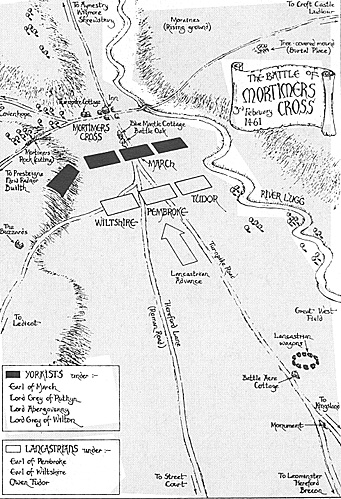 WARGAMING MORTIMER'S CROSS
WARGAMING MORTIMER'S CROSS
Mortimer's Cross makes an interesting wargames situation, and an alternative to the better-known and more frequently refought engagements of the Wars of the Roses. It provides an opportunity to match a variety of different types of troops against each other, and the two armies, though varying considerably in their charcteristics, are fairly evenly matched.
Though inevitably some of the details of the rival Orders of Battle must be conjectural, the suggestions which follow are both reasonably historically accurate, and will give a good "feel" of the battle.
Neither side has any artillery. The Yorkists are given higher overall morale ratings partly to account for any possible "parhelion effect", and for the more important reason that they were defending their home territory against the hated Welsh and their foreign allies!
Terrain and deployments should be as shown in the map. The possibility of a concealed ambush of Yorkist archers should be allowed for by the use of chance card or dice throwat the end of each turn. If such an ambush is declared, the Yorkist player may (though he is not required to do so) remove up to 6 longbowmen from amog his three divisions, and deploy them in position "B" as shown on the map.
Rules are otherwise as standard. The Lancastrians achieve a decisive victory by killing Edward of York. They may win a substantial victory if they occupy the crossroads, and rout the Yorkist army.
The Yorkists win a decisve victory by routing the Lancastrians. They win a substantial victory if they kill Jasper Tudor and hold the cross roads at the end of the battle, and a marginal victory if only securing the latter objective. Both sides score points for casualties inflicted.
PLAYER HINTS
Although the strategy for both players is generally straightforward, there are several considerations which each should bear in mind. The Yorkists have a considerable superiority in longbowmen, so they should attempt to inflict the maximimum number of casualties possible on Jasper Tudor's forces before melee begins. It is possible that some of the Lancastrians may rout as a result and help even the odds in hand-to-hand combat.
The Lancastrians, on the other hand, cannot afford a prolonged "stand-off"; they must attempt to close with the enemy as quickly as possible, in the hope that superior numbers and more suitable armament will prevail in the melee.
The Yorkists must at all times remember that if they lose Edward of York, they lose the battle. Unfortunately, they also need his leadership in battle, so must risk him - but that, after all, is one of the perils of medieval generalship!
FURTHER READING
ALAN COOK "Lance" Medieval wargame rules 3rd ed. 1982
GEOFFREY HODGES "Ludford Bridge and Mortimer's Cross" 1989
CHARLES HOPKINSON -"Herefordshire under Arms, a military history of the county", 1985
CHARLES ROSS "Edward IV", 1974
TERENCE WISE "The Wars of the Roses" 1978
Order of Battle
THE LANCASTRIAN ARMY
Jasper Tudor's force is assumed to be about 3,000 strong. On a suggested figure ratio of 20:1, the Lancastrian player will need 150 figures. The Lancastrian force should be organised in three divisions, assumed to be equal in size.
DIVISION 1 - "MAIN BATTLE" - 50 FIGURES
Battle Leader Jasper Tudor, Earl of Pembroke (also acts as Army Commander). Rated "Average".
5 "Super Heavy Infantry" (SHI) (regular household knights) Morale Class A
5 "Extra Heavy Infantry" (EHI) (regular men-at arms) Morale class A
10 "Medium Infantry" (MI) (regular longbowmen) Morale class A
10 "Medium Infantry" (MI) (feudal spearmen) Morale class B
20 "Light Infantry" (LI) (feudal longbowmen) Morale class B
15 "Light Infantry" (LI) (feudal, miscellaneous weapons) Morale Class C
DIVISION 2 - "VANGUARD" - 50 FIGURES
Battle Leader Owen Tudor (Rated "Average")
2 SHI (regular household knights) Morale class A
2 EHI (regular men-at-arms) Morale class A
4 MI (regular longbowmen) Morale class A
12 MI (feudal spearmen) Morale class B
10 LI (feudal longbowmen) Morale class B
20 LI (feudal, miscellaneous weapons) Morale class C
DIVISION 3 - "REARGUARD" - 50 FIGURES
Battle Leader James Butler, Earl of Wiltshire and Ormonde (Rated "Poor")
2 SHI (regular household knights) Morale class A
2 EHI (regular men-at-arms) Morale class A
2 MI (regular longbowmen) Morale class A
10 MI (feudal mercenary Irish gallowglasses, armed with axes) Morale class B
14 LI (feudal mercenary Irish kerns etc, armed with javelins, spears, light swords) Morale class C
20 MI (regular mercenary French and Bretons, 10 armed with crossbows, remainder with spears) Morale class B
THE YORKIST ARMY
Assumed to be about 2,500 men, and requiring a total of 125 figures. Organised in three divisions.
DIVISION 1- "MAIN BATTLE" - 60 FIGURES
Battle Leader Edward Duke of York (also acts as Army Commander) Rated "Veteran".
5 SHI (regular household knights) Morale class A
10 EHI (regular men-at-arms) Morale class A
10 MI (regular longbowmen) Morale Class A
20 LI (feudal longbowmen) Morale class B
15 LI (feudal, miscellaneous weapons)
Morale class B
DIVISION 2 - "VANGUARD" - 35 FIGURES Battle Leader Sir William Herbert (rated "Average")
2 SHI (regular household knights) Morale class A
2 EHI (regular men-at-arms) Morale class A
3 MI (regular longbowmen) Morale class A
18 LI (feudal longbowmen) Morale class B
10 LI (feudal, miscellaneous weapons)
Morale class B
DIVISION 3 - "REARGUARD" - 30 FIGURES
Battle Leader Sir Walter Deveraux (Rated "Average")
2 SHI (regular household knights) Morale class A
4 EHI (regular men-at-arms) Morale class A
4 MI (regular longbowmen) Morale class A
14 LI (feudal longbowmen) Morale class B
6 LI (feudal, miscellaneous weapons)
Morale class B
Mortimer's Cross "The Day of the Three Suns": February 3rd, 1461
Back to Battlefields Vol. 0 Issue 0 Table of Contents
Back to Battlefields List of Issues
Back to Master Magazine List
© Copyright 1995 by Partizan Press.
This article appears in MagWeb.com (Magazine Web) on the Internet World Wide Web. Other military history and related magazines are available at http://www.magweb.com